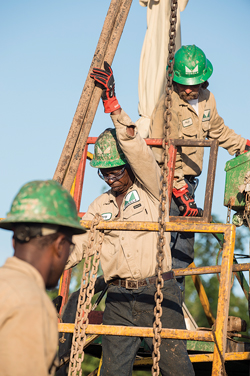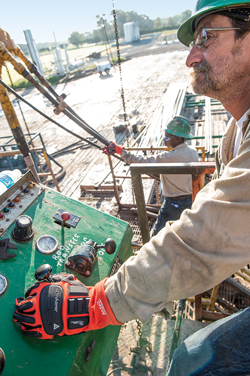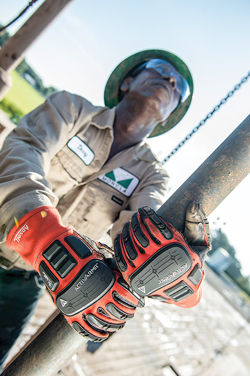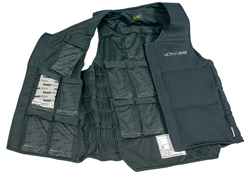The boom in North American oil and gas development in recent years has magnified the need to effectively, and consistently, protect the men and women engaged in dangerous work. The media reports on a daily basis about the challenges that operators and service companies face in finding, hiring, training and protecting the thousands of qualified employees, whose daily efforts fuel the nation’s economy.
Worker safety is a core value of every company in the industry, and publicly traded companies are graded by their safety records. Thus, minimizing lost-time incidents and protecting worker safety is not just critical to the health of the individuals, but also crucial to the companies’ financial well-being and performance. Protecting workers requires solutions with scale and sophistication.
The industry’s safety focus can be found in the daily briefings that take place in every aspect of activity, from small workover operations to large offshore platforms. That focus is also visible in the protective clothing worn by oilfield workers. Visitors to a drilling rig, or other significant oilfield operations, are always required to wear hard hats and steel-toed boots. In recent years, fire-related concerns have expanded those requirements to include a mandate by OSHA for flame-resistant clothing (FRC).
This focus on worker safety has yielded improvements in the industry’s safety record in the last several decades, but these efforts have not eliminated the occurrence of flash fires nor the resulting burn injuries and fatalities. Sixteen percent of oilfield fatalities result from fire or explosions. The use of FRC has significantly reduced the extent and severity of burn injuries to the body, while enhancing a worker’s recovery chances, if exposed to a flash fire. FRC greatly improves the chance of a worker surviving and regaining quality-of-life after a flash fire. Yet, while current standards require the use of FRC clothing, there is no such mandate for gloves.
Despite this omission in the regulatory structure, protection of workers’ hands is critical. The reality is that, whether day-to-day or an emergency situation, no part of a worker’s body is more at risk than his or her hands. Oil and gas workers need glove protection that stands up to the challenges of the field without slowing them down, a grip that won’t let go, and flame resistance that won’t wash out when laundered. Impact absorption and resistance are critical aspects of hand protection as well, given that so much work on a rig or a pipeline construction crew involves dealing with heavy equipment and materials, Fig. 1.
 |
| Fig. 1. Oilfield workers hoist drill pipe, wearing gloves that offer impact absorption and flame resistance. |
|
Yet not every job in the oil and gas field is the same. It’s not all heavy work—many oilfield workers must also perform tasks that require feel, touch and fine motor skills. These men and women need a glove that fights tough conditions, while providing manual dexterity and a feel that is almost skin-like.
Climatic conditions are also a key consideration. While almost half of America’s drilling rigs today are active in the hot and dry Eagle Ford shale and Permian basin regions of Texas, gloves must also provide warmth and waterproofing. Effective hand protection requires a glove that workers want to use, rather than have to use. The requirements and hazards involved in oil-and-gas-related work, from the wellhead to the burner tip, call for hand protection equipment that helps workers perform all aspects of their jobs efficiently, safely and comfortably, Fig. 2.
 |
| Fig. 2. Hand protection and dexterity are crucial elements for safe field operations. |
|
THE SOLUTION PROVIDER
Since emerging as a rubber company in Australia in 1905, Ansell has been among leading firms in hand protection solutions, and has been recognized for continually innovating and leading the hand protection and protective clothing industry. By adapting new technologies that answer customer concerns while making them safer and more productive, Ansell is able to provide personal protective equipment to the upstream, midstream and downstream sectors of the oil and gas industry. These advancements are keeping the men and women developing these important resources safe on the job, while ensuring their performance, protection and comfort needs.
By having a presence in over 35 countries, Ansell is able to offer large-scale protection solutions to the global oil and gas industry. The major integrated companies, and their service providers, operate in every major production arena, and Ansell serves the industry’s PPE needs with sales-and-distribution facilities in close proximity to most major plays. Feedback from industry stakeholders, and input from hundreds of oil and gas workers, is a practice that Ansell follows to deliver the right kind of in-field solution.
STEMMING FROM RESEARCH
Ansell boasts eight research and development facilities, with 170 dedicated researchers across the globe, and holds more than 270 worldwide patents. This R&D resource has been directed toward creating a portfolio of flame-resistant gloves to injection-molded products for enhanced dexterity and impermeability, and grip technologies for improved productivity, as well as worker safety.
Part of this innovation stems from the Ansell Guardian program, a suite of management tools helping manufacturing companies to improve safety while also developing new perspectives for increased productivity and savings. Ansell Guardian offers a customized, personal approach to maximizing return on a company’s personal protective equipment investment. The program analyzes these key areas and integrates them into an easy-to-understand optimization plan for customers to maximize ROI on PPE.
By providing customers with tailored plans to improve workers’ safety and productivity, and offering a unique, personal approach to maximizing return on a company’s personal protective equipment investment, they enable others to perform better. The industry requires, and expects, its service company partners to provide support.
CASE STUDIES
Companies throughout the world are finding that recent innovations in gloves designed for oil and gas operations are addressing unmet workers’ needs. What follows are several case study examples.
#1, North Dakota. An environmental services division of a global waste services corporation, handling oil and gas production service needs in the Bakken shale, needed flame-resistant protection that could stand up to North Dakota winters. The ActivArmr 97-201 (Fig. 3) is a durable FR glove, and in field testing, proved to be a great glove in frigid weather, handling temperatures below -10°F. It also proved that it has the durability to stand up to the wear-and-tear of the environment.
 |
| Fig. 3. The ActivArmr 97-201 is an FR glove that offers grip and protection in fields as demanding as the Bakken shale. |
|
#2, Western U.S. An international oil-field services company was seeking a universal glove, to be worn across various services and temperatures for winter use, from Texas to Wyoming. The ActivArmr 97-210 held up in cold-climate testing and, along with insulator gloves, proved that it can be a solution for below-zero temperatures.
#3, Middle East. A global drilling contractor was seeking coordinated PPE support in the Middle East, where customers and business practices in the various countries in which the firm operates are driving up PPE costs. In response, Ansell provided a regional solution, supported by sales offices and stocking distributor partners in each country where the driller operated. This enabled the drilling firm to contain costs and ensure availability.
#4, Worldwide dexterity. Artificial lift technicians at a major global oilfield services company were having “hand cut” issues when using a thin glove, which they needed to ensure enough dexterity to do their jobs. Working in low light, or at night, made it even more of a hazardous work environment. Ansell’s range of Hi-Viz, high-cut protection gloves offered the dexterity that they needed, combined with cut resistance that protected from sharp edges. The high-visibility yarns and reflective logo offered them a solution that they could use around the clock, in shops worldwide.
SITUATION-SPECIFIC SOLUTIONS
Workers on oil and gas drilling sites face demanding work environments, and each and every day, their hands are always closest to the danger. To meet these needs, Ansell is extending flame-resistant protection to the hand. In addition to hand protection, the Ansell Trellchem range of chemical protective clothing furthers the protection of the wearer, through its wide-range of Level A, Level B, and Splash suits.
Many of these products are certified against the world’s toughest standards, including NFPA 1991 and EN 943-2, and are also rated against chemical flash fires. Coupled with the protection elements of these products, they provide enhanced comfort and usability by incorporating features, such as hands-free visor lights and permanently-attached anti-fog shields. Most of the Trellchem products are also field-repairable, which is significant for many upstream customers based in remote operating regions.
For everyday safety environments, Ansell is adding another range of chemical protective clothing to the portfolio—the Sawyer-Tower industrial chemical splash protective work wear, made from unique Gore trilaminate materials. The overarching benefit of this product line is breathability, which does not sacrifice chemical protection and resistance to flame and arc protection, helping the wearer stay protected and more comfortable throughout a full shift.
HEAT PROTECTION
With increased oil and gas development in very hot areas of the world, heat-related disorders and heat stress prevention are constantly in the minds of oil and gas workers. Heat stress can result in heat stroke, heat exhaustion, heat cramps, or heat rashes.
 |
| Fig. 4. The ActivArmr Cooling Vest is a garment that prevents elevated body temperatures while in hot environments, or with great physical exertion. |
|
Accordingly, Ansell has designed the ActivArmr Cooling Vest (Fig. 4), a garment developed to prevent elevated body temperatures for those who work in hot environments, or with extreme physical exertion. The true uniqueness of this product is in its technology. This vest is not cooling the skin down like many other cooling products, but actually reducing heat stress based on dry elements. These elements are absorbing and store excessive heat up to 4 hr, with a rechargeable ability within 2 hr at room temperature without external energy. Most of all, this technology is safe for the cardiovascular system. 
|






